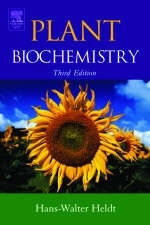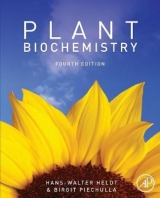
Plant Biochemistry
Academic Press Inc (Verlag)
978-0-12-088391-2 (ISBN)
- Titel erscheint in neuer Auflage
- Artikel merken
This fully revised translation of the world-renowned German edition covers the complete and modern knowledge of plant biochemistry. The book presents the topic in a concise and simplified manner so that students can digest the message and gain a basic knowledge of the entire field of plant biochemistry, from photosynthesis (the synthesis of natural plant products) to all kinds of genetic engineering with its many commercial applications. Topics include cell structure and function, lipid and polysaccharide metabolism, nitrogen fixation, phloem transport, synthesis and function of isoprenoids, phenylpropanoids and other secondary metabolites, plant growth regulation and development. Heldt provides a comprehensive description of photosynthesis, primary and secondary metabolism, the function of phytohormones and molecular engineering. The text covers research findings until the end of 2003 and identifies areas of future research. There are extensive references to the most recent scientific literature.
Hans-Walter Heldt was a professor at the University of Göttingen in the Department of Biochemistry of the plant. He is co-authored over 250 scientific publications and is the co-author of the textbook, Plant Biochemistry. In 1993, he was awarded the Max Planck Research Award together with Marshall Davidson Hatch . Since 1990, he has been a full member of the Göttingen Academy of Sciences. Birgit Piechulla’s current research focus is to understand the biosynthesis and regulation of volatile organic compounds of bacteria and plants (flowers) and to elucidate the underlying molecular and cellular mechanisms and reactions, including signal transduction, in the mVOC receiver. She published 112 peer-reviewed publications, 25 book articles and non-peer-reviewed articles (Researchgate h-index 37). Her book, Plant Biochemistry, co-written with H.W. Heldt has been published in German, English, Russian, Japanese, Indian, Chinese and Turkish. From 1998 - 2013 she was co-editor of Plant Biology, board member of the Deutsche Botanische Gesellschaft (DBG) (2009-2016), board member of the Society of Biochemistry and Molecular Biology (GBM) (2008-2016), councilor of the Int. Society of Chemical Ecology (ISCE) (2014- 2017), and she held several academic positions within the university, including Vice Rector for Science at the University of Rostock (2,5 years, 2013-2015).
1 A Leaf Cell Consists of Several Metabolic Compartments
2 The Use of Energy from Sunlight by Photosynthesis is the Basis of Life on Earth
3 Photosynthesis is an Electron Transport Process
4 ATP is Generated by Photosynthesis
5 Mitochondria are the Power Station of the Cell
6 The Calvin Cycle Catalyzes Photosynthetic CO2 Assimilation
7 In the Photorespiratory Pathway Phosphoglycolate Formed by the Oxygenase Activity of RubisCo is Recycled
8 Photosynthesis Implies the Consumption of Water
9 Polysaccharides are Storage and Transport Forms of Carbohydrates Produced by Photosynthesis
10Nitrate Assimilation is Essential for the Synthesis of Organic Matter
11 Nitrogen Fixation Enables the Nitrogen in the Air to be Used for Plant Growth
12 Sulfate Assimilation Enables the Synthesis of Sulfur Containing Substances
13 Phloem Transport Distributes Photoassimilates to the Various Sites of Consumption and Storage
14 Products of Nitrate Assimilation are Deposited in Plants as Storage Proteins
15 Glycerolipids are Membrane Constituents and Function as Carbon Stores
16 Secondary Metabolites Fulfill Specific Ecological Functions in Plants
17 Large Diversity of Isoprenoids has Multiple Funtions in Plant Metabolism
18 Phenylpropanoids Comprise a Multitude of Plant Secondary Metabolites and Cell Wall Components
19 Multiple Signals Regulate the Growth and Development of Plant Organs and Enable Their Adaptation to Environmental Conditions
20 A Plant Cell has Three Different Genomes
21 Protein Biosynthesis Occurs at Different Sites of a Cell
22 Gene Technology Makes it Possible to Alter Plants to Meet Requirements of Agriculture, Nutrition, and Industry
| Erscheint lt. Verlag | 7.10.2004 |
|---|---|
| Verlagsort | San Diego |
| Sprache | englisch |
| Gewicht | 1400 g |
| Themenwelt | Naturwissenschaften ► Biologie ► Biochemie |
| Naturwissenschaften ► Biologie ► Botanik | |
| ISBN-10 | 0-12-088391-0 / 0120883910 |
| ISBN-13 | 978-0-12-088391-2 / 9780120883912 |
| Zustand | Neuware |
| Haben Sie eine Frage zum Produkt? |
aus dem Bereich



